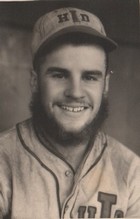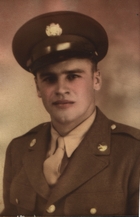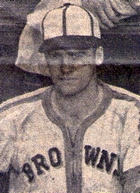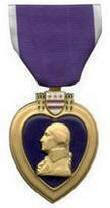Art Keller
| Date and Place of Birth: | July 28, 1916 Octavia, NE |
| Date and Place of Death: | September 29, 1944 Vosges, France |
| Baseball Experience: | Minor League |
| Position: | Catcher |
| Rank: | Corporal |
| Military Unit: | Company D, 142nd Infantry Regiment, 36th Infantry Division US Army |
| Area Served: | European Theater of Operations |
Art Keller was a semi-pro All-American and with the St Louis Browns for spring training in 1943. Then military service beckoned and the young catcher was off to serve his nation in Europe.
Ardys B. “Art” Keller, the son of George and Amy Keller, grew up on
his familiy's farm near Octavia, Nebraska. He gained recognition as a
hard-hitting catcher with American Legion junior ball teams in the
nearby towns of David City and Schuyler. After graduating from high
school in 1934, he played amateur baseball for two years with Schuyler
in the Elkhorn Valley League. In 1936, he had a brief trial with the
Palestine Pals of the newly formed Class C East Texas League before
being released in May.
Returning home he joined the Nebraska Powers, the semi-pro team of the
Iowa-Nebraska Light and Power Company of Lincoln, which played in the
Lincoln Baseball League. The Powers were Nebraska State semi-pro
champions in 1937, and advanced to the National Baseball Congress
tournament at Wichita, Kansas, where Keller was an All-America
selection. Keller attracted a lot of attention at the Wichita tournament
and it was rumored he would join the New York Yankees organization.
However, by the beginning of 1938 he had not received an offer and was
recommended by Johnny Bretzer, manager of the Woodmen team of the
Lincoln City League, to John R. Tucker, manager of the House of David
club—a famous barnstorming team with a religious background renowned for
their long hair and beards—which toured rural America playing amateur
and semi-pro teams in exhibition games.
On January 24, 1938, Tucker wrote to Keller inviting him to join the
House of David team, offering him $160 a month, with the team taking
care of hotel bills and transportation, while Keller would be
responsible for meals and laundry.1 As the team’s starting catcher,
Keller traveled through 44 states and parts of Canada, playing 168 games
and batting .322. His teammates included House of David veterans George
“Andy” Anderson and Jesse “Doc” Tally. Among the other players were
former minor leaguers Walt Nawoj, Sam Munitz, Bill Pike, Herbert “Hub”
Hansen, Arnie Velcheck, Cliff Clay, Myron Apple, Morris Young, and
Merritt Hubbell, younger brother of Carl Hubbell.
On August 22, Keller was back in Lincoln, Nebraska, as the House of
David played the Lincoln team at Landis Field. Before a crowd of 1,350,
the House of David put together a three-run ninth-inning rally to clinch
the game, 8–7. Keller had a big night with three hits and threw out
three Lincoln base runners. Playing with the House of David gave Keller
the exposure he needed. He was signed by the St. Louis Browns’
organization in February 1939, and joined the Springfield Browns of the
Class B Three-I League, where he batted .266. Keller, 23, joined the San
Antonio Missions of the Texas League for spring training in 1940, but
was returned to Springfield for the regular season. It was a year of
highs and lows for the young catcher. The team got off to a flying
start, winning its first seven games, but then went into a slump. Keller
was hampered by injuries for much of the year and batted .280 in 56
games, but the season ended on a personal high; he married his hometown
sweetheart, Ruth Peters, on August 31, at St. Charles, Missouri, with a
wedding party staged at Springfield’s Lanphier Park later in the day.
Keller was back with Springfield for a third campaign in 1941. In 87
games he batted .293 and hit eight home runs, helping the club to a
Three-I League playoff birth. But on September 11, two games into the
best-of-five series against Cedar Rapids, Springfield lost the services
of its young catcher when he was hospitalized for an emergency
appendectomy.
In 1942, Keller made a leap through the Browns’ organization to the
Toledo Mud Hens of the Class AA American Association - one level below
the major leagues - and shared catching duties with Hal Spindel (who
would make it to the Phillies in 1945). In 64 games, he batted .269 and
made just two errors in 63 games behind the plate, prompting the Browns
to invite him to St. Louis in September. Spring training at Cape
Girardeau, Missouri, in 1943, saw Keller as one of four catchers on the
Browns’ spring roster. While veterans Frankie Hayes and Rick Ferrell
were certain to make the club, Keller and Joe Schultz (who had hit .330
with Memphis in 1942) were vying for the third-string spot. Not until
April 12, nine days before opening day, did manager Luke Sewell make a
decision to keep Schultz and return Keller to Toledo on 24-hour option.
Splitting the Mud Hen catching duties with Red Hayworth, Keller played
79 games and batted .229. The team finished fourth and was quickly
eliminated by the Indianapolis Indians in the American Association
playoffs, and Keller’s last game of the season was as a late-inning
replacement for Hayworth in the fourth game of the playoffs on September
24.
Two weeks later, on October 6, 1943, Keller entered military service
with the Army. Carried on the St. Louis Browns’ National Defense Service
List, he was inducted at Fort Benjamin Harrison, Indiana, and was
assigned to the 36th “Texas” Infantry Division’s infantry training unit
at Camp Blanding, Florida. In May 1944, he was promoted to corporal and
assigned to a cadre as an instructor, serving in that capacity until he
was transferred to Fort George G. Meade, Maryland. In July 1944, Keller
left the United States for overseas duty and joined Company D of the
142nd Infantry Regiment, 36th Infantry Division in Paestum, Italy. For
six weeks he was stationed with his brother, Sergeant Dale E. Keller.
On August 15, as part of the American Sixth Army Group, the division
made an amphibious assault landing against light German opposition in
the Saint-Raphaël area of southern France as part of Operation Dragoon.
A rapid advance opened the Rhone River Valley, and Montélimar fell on
August 28. The 36th Infantry Division then advanced to the Moselle River
at Remiremont and the foothills of the Vosges mountain range, where they
met with bitter resistance in the steady rain and thick wilderness. On
September 29, 1944, near the French town of Biffontaine, Corporal Keller
was killed in action. He had been in military service less than a year.
Art Keller is buried at Edholm Cemetery in Octavia, Nebraska.
Keller was carried on the St. Louis Browns’ National Defense Service List when he entered military service.
|
Team |
League |
Class |
G |
AB |
R |
H |
2B |
3B |
HR |
RBI |
AVG |
|
| 1936 | Palestine | East Texas | C | - | - | - | - | - | - | - | - | - |
| 1937 to 1938 | Played semi-pro in 1937 and with House of David in 1938 | |||||||||||
| 1939 | Springfield | Three-I | B | 60 | 158 | 20 | 42 | 0 | 3 | 6 | 27 | .266 |
| 1940 | Springfield | Three-I | B | 56 | 164 | 21 | 46 | 9 | 3 | 3 | 28 | .280 |
| 1941 | Springfield | Three-I | B | 87 | 294 | 45 | 86 | 16 | 2 | 8 | 57 | .293 |
| 1942 | Toledo | American Assoc | AA | 64 | 193 | 15 | 52 | 6 | 0 | 0 | 17 | .269 |
| 1943 | Toledo | American Assoc | AA | 79 | 231 | 19 | 53 | 10 | 1 | 0 | 18 | .229 |
Date Added February 1, 2012 Updated June 5, 2014
Baseball's Greatest Sacrifice is associated with Baseball Almanac
Baseball's Greatest Sacrifice is proud to be sponsored by




